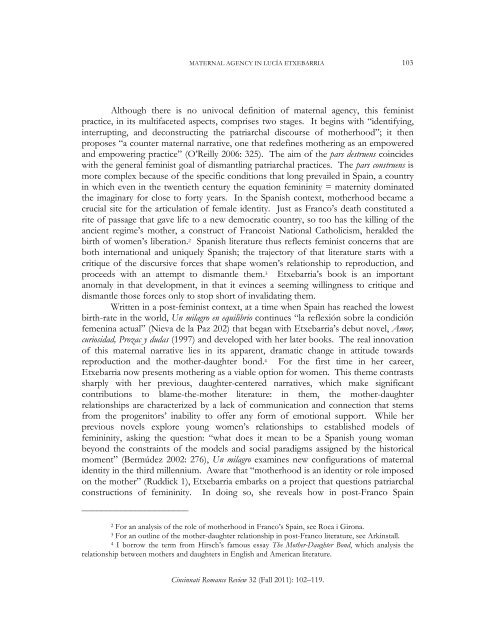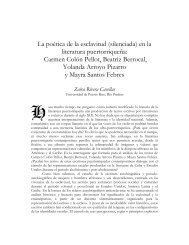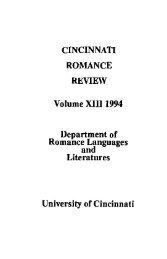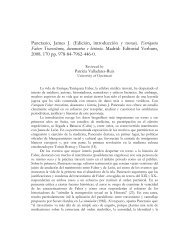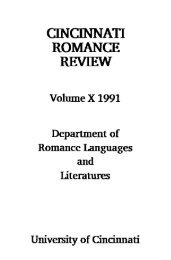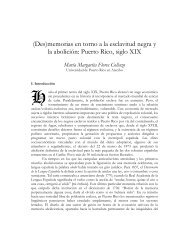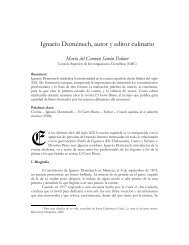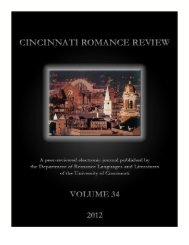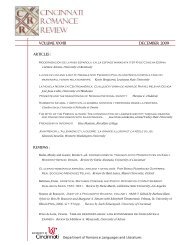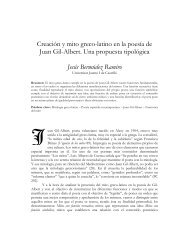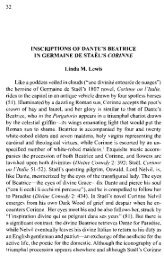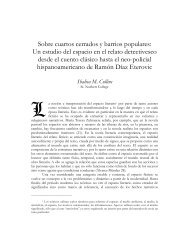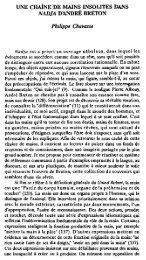Maternal Agency in Lucía Etxebarria’sUn milagro en equilibrioMarina BettaglioUniversity of VictoriaLa maternidad ocupa, a finales del sigloXX, el lugar que correspondía a lasexualidad en la segunda mitad del XIX:la sede de conflictos que no se puedenenunciar ni pensar.Silvia Vegetti-FinziAwarded the prestigious Planeta literary prize in 2004, Un milagro en equilibrioconsecrates Lucía Etxebarria among the most prominent Spanish literaryfigures, while it inaugurates a new authorial persona, that of a mother. Fora highly commercial author with a strong media presence, often identifiedwith her depiction of dissident sexualities, writing a first-person narrative from amaternal perspective implies assuming an unexpected identity, in apparent contrast withher previous “impersonations.” Acquiring a maternal role and writing a matrifocalnarrative, nonetheless, need not entail a break with Etxebarria’s iconoclasm, as adetailed reading of the novel will point out. 1 This analysis will show that Un milagro ismore complex than it looks, in that it undermines the potentially subversive maternaldiscourse it articulates. Examining this novel within the literary and critical productionof this controversial writer, I question the feminist claims displayed in thiscommercialized portrait of transgressive maternity. On its surface, the novel succeedsin its aim to “interrupt the master narrative of motherhood,” which, according toAndrea O’Reilly, is one of the goals of a feminist practice of mothering (2006: <strong>32</strong>6); butat a deeper level, Un milagro en equilibrio reinscribes that master narrative by undoing,even denying, women’s agency in reproduction.______________________1 As Elizabeth Podnieks and Andrea O’Reilly point out, “A matrifocal narrative, then,borrowing Johnson’s terminology, is one in which a mother plays a role of cultural and social significance,and in which motherhood is thematically elaborated and valued, and structurally central to the plot” (3)
MATERNAL AGENCY IN LUCÍA ETXEBARRIA 103Although there is no univocal definition of maternal agency, this feministpractice, in its multifaceted aspects, comprises two stages. It begins with “identifying,interrupting, and deconstructing the patriarchal discourse of motherhood”; it thenproposes “a counter maternal narrative, one that redefines mothering as an empoweredand empowering practice” (O’Reilly 2006: <strong>32</strong>5). The aim of the pars destruens coincideswith the general feminist goal of dismantling patriarchal practices. The pars construens ismore complex because of the specific conditions that long prevailed in Spain, a countryin which even in the twentieth century the equation femininity = maternity dominatedthe imaginary for close to forty years. In the Spanish context, motherhood became acrucial site for the articulation of female identity. Just as Franco’s death constituted arite of passage that gave life to a new democratic country, so too has the killing of theancient regime’s mother, a construct of Francoist National Catholicism, heralded thebirth of women’s liberation. 2 Spanish literature thus reflects feminist concerns that areboth international and uniquely Spanish; the trajectory of that literature starts with acritique of the discursive forces that shape women’s relationship to reproduction, andproceeds with an attempt to dismantle them. 3 Etxebarria’s book is an importantanomaly in that development, in that it evinces a seeming willingness to critique anddismantle those forces only to stop short of invalidating them.Written in a post-feminist context, at a time when Spain has reached the lowestbirth-rate in the world, Un milagro en equilibrio continues “la reflexión sobre la condiciónfemenina actual” (Nieva de la Paz 202) that began with Etxebarria’s debut novel, Amor,curiosidad, Prozac y dudas (1997) and developed with her later books. The real innovationof this maternal narrative lies in its apparent, dramatic change in attitude towardsreproduction and the mother-daughter bond. 4 For the first time in her career,Etxebarria now presents mothering as a viable option for women. This theme contrastssharply with her previous, daughter-centered narratives, which make significantcontributions to blame-the-mother literature: in them, the mother-daughterrelationships are characterized by a lack of communication and connection that stemsfrom the progenitors’ inability to offer any form of emotional support. While herprevious novels explore young women’s relationships to established models offemininity, asking the question: “what does it mean to be a Spanish young womanbeyond the constraints of the models and social paradigms assigned by the historicalmoment” (Bermúdez 2002: 276), Un milagro examines new configurations of maternalidentity in the third millennium. Aware that “motherhood is an identity or role imposedon the mother” (Ruddick 1), Etxebarria embarks on a project that questions patriarchalconstructions of femininity. In doing so, she reveals how in post-Franco Spain______________________2 For an analysis of the role of motherhood in Franco’s Spain, see Roca i Girona.3 For an outline of the mother-daughter relationship in post-Franco literature, see Arkinstall.4 I borrow the term from Hirsch’s famous essay The Mother-Daughter Bond, which analysis therelationship between mothers and daughters in English and American literature.<strong>Cincinnati</strong> <strong>Romance</strong> <strong>Review</strong> <strong>32</strong> (Fall <strong>2011</strong>): 102–119.
- Page 1 and 2:
CINCINNATI ROMANCE REVIEWA peer-rev
- Page 4 and 5:
External readersAbraham AcostaDanie
- Page 6 and 7:
!Juan Luis Vives y Erasmo de Rotter
- Page 8 and 9:
!Mayhew, Jonathan. Apocryphal Lorca
- Page 10 and 11:
2 SHALISA M. COLLINS(Álvarez Ménd
- Page 12:
4 SHALISA M. COLLINSinvoluntary exp
- Page 15 and 16:
SOBRE CUARTOS CERRADOS Y BARRIOS PO
- Page 17 and 18:
SOBRE CUARTOS CERRADOS Y BARRIOS PO
- Page 19 and 20:
SOBRE CUARTOS CERRADOS Y BARRIOS PO
- Page 21 and 22:
Tanto de aquí como de allá: NewRe
- Page 24 and 25:
16 CARYN CONNELLYbelief that social
- Page 26 and 27:
18 CARYN CONNELLYPaso through the U
- Page 28 and 29:
20 CARYN CONNELLYpresent something
- Page 30 and 31:
22 CARYN CONNELLYprovincialism. The
- Page 32 and 33:
24 CARYN CONNELLYneatly represent t
- Page 34 and 35:
26 CARYN CONNELLYtreatment of Carli
- Page 36 and 37:
28 CARYN CONNELLYConclusionsOne of
- Page 38 and 39:
30 CARYN CONNELLYGoldbarg, Pablo.
- Page 40 and 41:
32 NICOLÁS FERNÁNDEZ-MEDINAavance
- Page 42 and 43:
34 NICOLÁS FERNÁNDEZ-MEDINAEs cla
- Page 44 and 45:
36 NICOLÁS FERNÁNDEZ-MEDINAde los
- Page 46 and 47:
38 NICOLÁS FERNÁNDEZ-MEDINAasí d
- Page 48 and 49:
40 NICOLÁS FERNÁNDEZ-MEDINAfigura
- Page 50 and 51:
42 NICOLÁS FERNÁNDEZ-MEDINAdel gr
- Page 52 and 53:
Gran Señor y rajadiablos: Sátira
- Page 56:
48 LUIS HERMOSILLAfamiliar en el es
- Page 60 and 61: 52 LUIS HERMOSILLAAferrado a los co
- Page 62 and 63: 54 LUIS HERMOSILLAVicuña Urrutia,
- Page 64 and 65: 56 PAOLA MARÍNligüística, el cua
- Page 66 and 67: 58 PAOLA MARÍNy referencias en su
- Page 68 and 69: 60 PAOLA MARÍNLa renovación que l
- Page 70 and 71: 62 PAOLA MARÍNclave en Borges, sin
- Page 72 and 73: 64 PAOLA MARÍNdel bachiller Franci
- Page 74 and 75: 66 PAOLA MARÍNdebe sobresalir. En
- Page 76 and 77: 68 PAOLA MARÍN---. “Francisco de
- Page 78 and 79: Juan Luis Vives y Erasmo de Rotterd
- Page 80 and 81: 72 OLGA RIVERAingenios y escritores
- Page 82 and 83: 74 OLGA RIVERAque reproducen en min
- Page 84 and 85: 76 OLGA RIVERAentre otros argumento
- Page 86 and 87: 78 OLGA RIVERAreaches age seven) lo
- Page 88 and 89: 80 OLGA RIVERAand hard work” (Ree
- Page 90 and 91: 82 OLGA RIVERAoccupation for the ju
- Page 92 and 93: 84 OLGA RIVERAámbito de la domesti
- Page 94 and 95: Góngora’s “Esperando están la
- Page 96 and 97: 88 DIANE CHAFFEE-SORACEWhereas the
- Page 98 and 99: 90 DIANE CHAFFEE-SORACEIn Góngora
- Page 100 and 101: 92 DIANE CHAFFEE-SORACEHowever, whe
- Page 102 and 103: 94 DIANE CHAFFEE-SORACEThe bard’s
- Page 104 and 105: 96 DIANE CHAFFEE-SORACEthe fifteent
- Page 106 and 107: 98 DIANE CHAFFEE-SORACE1563 to 1700
- Page 108 and 109: 100 DIANE CHAFFEE-SORACEGilmer, Mau
- Page 112 and 113: 104 MARINA BETTAGLIOprocreation no
- Page 114 and 115: 106 MARINA BETTAGLIOwho rescued her
- Page 116 and 117: 108 MARINA BETTAGLIOmystical interv
- Page 118 and 119: 110 MARINA BETTAGLIOnot represent t
- Page 120 and 121: 112 MARINA BETTAGLIOproductions. Li
- Page 122 and 123: 114 MARINA BETTAGLIO“Sé que est
- Page 124 and 125: 116 MARINA BETTAGLIOtheir real-life
- Page 126 and 127: 118 MARINA BETTAGLIO---. “Acerca
- Page 128 and 129: Tu mettrais l’univers entier dans
- Page 130 and 131: 122 JEAN-FRANÇOIS DUCLOS(Battues 4
- Page 132 and 133: 124 JEAN-FRANÇOIS DUCLOSpaupière,
- Page 134 and 135: 126 JEAN-FRANÇOIS DUCLOSmaintient.
- Page 136 and 137: 128 JEAN-FRANÇOIS DUCLOSne peut qu
- Page 138 and 139: 130 JEAN-FRANÇOIS DUCLOSEt pour ce
- Page 140 and 141: 132 JEAN-FRANÇOIS DUCLOSŒUVRES CI
- Page 142 and 143: 134 REGINA L. PESZATsimplicity, Ern
- Page 144 and 145: 136 REGINA L. PESZATbourgeoises de
- Page 146 and 147: 138 REGINA L. PESZATTransfiguration
- Page 148 and 149: 140 REGINA L. PESZATthe impoverishe
- Page 150 and 151: 142 REGINA L. PESZATillusion simila
- Page 152 and 153: 144 REGINA L. PESZATOne might hypot
- Page 154 and 155: Entre deux régimes de censure:Le c
- Page 156 and 157: 148 EDWARD OUSSELINEn France, “l
- Page 158 and 159: 150 EDWARD OUSSELINquelque sorte, p
- Page 160 and 161:
152 EDWARD OUSSELINsocialement bann
- Page 162 and 163:
154 EDWARD OUSSELINEmmanuelle (Just
- Page 164 and 165:
156 EDWARD OUSSELINUn reflet peu no
- Page 166 and 167:
158 EDWARD OUSSELINHeise, William,
- Page 168 and 169:
When Feasting with the Statue Is Du
- Page 170 and 171:
162 KATHRYN WILLIS WOLFEAu tournant
- Page 172 and 173:
164 KATHRYN WILLIS WOLFEproblematic
- Page 174 and 175:
166 KATHRYN WILLIS WOLFEformed part
- Page 176 and 177:
168 KATHRYN WILLIS WOLFEto imitate,
- Page 178 and 179:
170 KATHRYN WILLIS WOLFEthe word ca
- Page 180 and 181:
172 KATHRYN WILLIS WOLFEemerging se
- Page 182 and 183:
174 KATHRYN WILLIS WOLFEpromises, w
- Page 184 and 185:
176 REVIEWED BY PATRICIA VALLADARES
- Page 186 and 187:
Alberca, Manuel. El pacto ambiguo:
- Page 188 and 189:
180 REVIEWED BY ANDRÉS PÉREZ-SIMO
- Page 190 and 191:
Álvarez, Enrique. DENTRO/FUERA: El
- Page 192 and 193:
184 REVIEWED BY BEATRIZ CELAYA CARR
- Page 194 and 195:
ROMANCERO 179Hispanista ya había p
- Page 196 and 197:
ROMANCERO 181Aunque no ha encontrad
- Page 198 and 199:
Fisher, Andrés. Series. Poesía re
- Page 200 and 201:
192 REVIEWED BY MARÍA CLEMENCIA S
- Page 202 and 203:
194 REVIEWED BY MANUEL CERPAAunque
- Page 204 and 205:
196 REVIEWED BY MANUEL CERPAtanto d
- Page 206 and 207:
198 REVIEWED BY PEDRO P. PORBÉNent
- Page 208 and 209:
200 REVIEWED BY PEDRO P. PORBÉNEn


